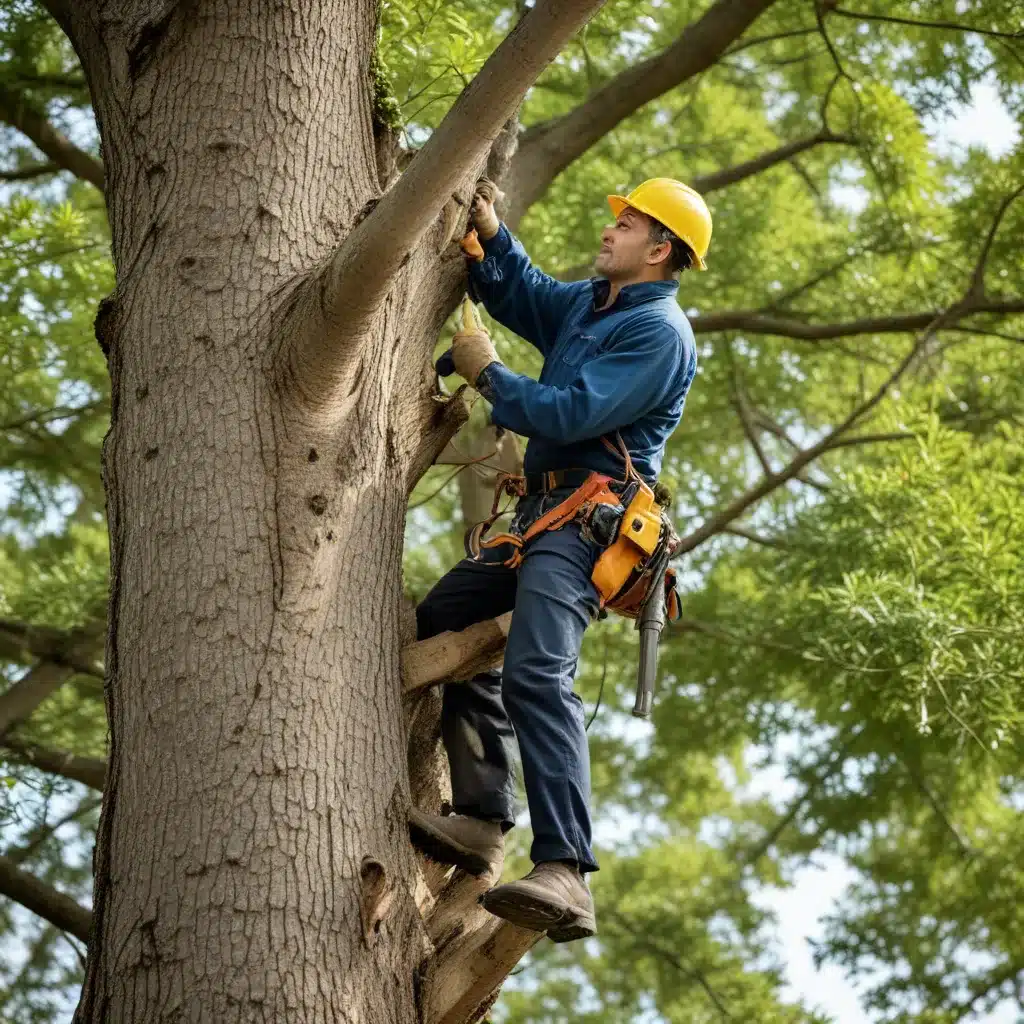
As a tree care specialist at TriCounty Tree Care, I understand the delicate balance between do-it-yourself (DIY) maintenance and professional arboricultural services. A well-designed and cared-for landscape requires a thoughtful approach that leverages the strengths of both methods. By judiciously combining DIY techniques and professional expertise, homeowners can cultivate a vibrant, resilient, and visually stunning outdoor environment.
Tree Care Approaches
DIY Tree Maintenance
For the discerning homeowner, undertaking certain tree care tasks can be a rewarding and cost-effective endeavor. Pruning, for instance, is a fundamental skill that can be mastered with the right guidance. By learning the principles of thinning, heading, and reduction, DIY enthusiasts can shape the structural integrity and aesthetic appeal of their trees. Proper mulching techniques and judicious fertilization regimens can also promote vigorous growth and nutrient cycling within the soil.
Homeowners equipped with a keen eye and basic pest identification knowledge can even tackle disease and insect management through targeted, organic approaches. Applying horticultural oils, deploying beneficial insects, or strategically removing affected plant parts can often resolve localized issues without resorting to harsh chemicals.
Professional Tree Services
While DIY efforts can be immensely valuable, there are certain circumstances where the expertise of a certified arborist is indispensable. Complex tree procedures, such as crown reduction, cabling, or lightning protection system installation, require specialized training and equipment. Arborists can also provide comprehensive tree risk assessments, identifying potential hazards and recommending appropriate mitigation strategies.
In cases of storm damage, emergency pruning, or the need for removal, professional tree care companies possess the skills and resources to address these challenges swiftly and safely. Their knowledge of local tree species, growth patterns, and environmental conditions allows them to devise tailored solutions that prioritize the long-term health and stability of the landscape.
Balancing DIY and Professional Care
By thoughtfully integrating DIY maintenance and professional tree services, homeowners can cultivate a thriving, low-maintenance landscape. Regular DIY pruning, mulching, and pest monitoring can complement periodic arborist visits for more complex procedures or comprehensive evaluations. This approach ensures that trees receive the appropriate level of care, with homeowners leveraging their own capabilities while capitalizing on the expertise of trained professionals.
Landscape Considerations
Tree Health and Growth
Maintaining the overall health and vigor of trees is a fundamental objective in any landscape management strategy. Careful pruning techniques, such as thinning to improve airflow and reduce disease susceptibility, can enhance a tree’s resistance to pests and environmental stressors. Judicious fertilization with organic amendments, like compost or bone meal, can replenish vital nutrients and foster robust root development.
Aesthetic Appeal
Trees not only serve practical functions but also contribute significantly to the visual appeal of a landscape. Skillful pruning can shape the form and structure of trees, highlighting their natural branching patterns and foliage characteristics. Coordinating planting and maintenance with surrounding hardscapes, garden beds, and focal points can elevate the overall aesthetic harmony of the outdoor space.
Functional Benefits
Beyond their aesthetic value, trees provide a multitude of functional benefits that enhance the quality of life for homeowners. Strategically placed shade trees can reduce cooling costs and mitigate the urban heat island effect. Windbreak plantings can shield structures from the elements, while privacy trees and hedges can create visual barriers and noise attenuation. The judicious integration of these functional considerations into the landscape design is crucial for maximizing the benefits of a thriving tree canopy.
DIY Tree Care Techniques
Pruning and Trimming
Pruning is a fundamental DIY tree care technique that can be applied throughout the year to address various objectives, such as structural training, size control, or hazard mitigation. Homeowners should familiarize themselves with the principles of thinning, heading, and reduction cuts to selectively remove competing or damaged branches, encourage balanced growth, and maintain desired aesthetic qualities.
Mulching and Fertilization
Proper mulching around the root zone of trees can significantly improve soil moisture retention, suppress weed growth, and insulate against temperature extremes. Homeowners can apply a 2-4 inch layer of organic mulch, such as wood chips or shredded bark, while maintaining a gap around the trunk to prevent rot or pest infestations.
Fertilization with organic amendments, like compost, bone meal, or alfalfa meal, can replenish essential nutrients and foster a thriving soil ecosystem. Homeowners should avoid synthetic fertilizers, which can disrupt the soil microbiome and lead to environmental pollution.
Pest and Disease Management
Vigilant monitoring and early intervention are key to managing pest and disease issues in the landscape. Homeowners can learn to identify common tree pests and pathogens, such as aphids, borers, or fungal infections, and employ organic control methods, including horticultural oils, beneficial insects, or targeted pruning.
Professional Tree Care Expertise
Arborist Assessments
Certified arborists possess specialized knowledge and training to evaluate the overall health, structural integrity, and risk associated with trees in the landscape. Through comprehensive inspections and diagnostics, they can identify potential hazards, recommend mitigation strategies, and develop long-term management plans tailored to the specific needs of each tree.
Advanced Tree Procedures
For more complex tree care tasks, the expertise of professional arborists is invaluable. Crown reduction, cabling, or the installation of lightning protection systems require specialized equipment and techniques to ensure the safety and well-being of the tree. Arborists can also perform complex removals, stump grinding, and transplanting operations with the necessary machinery and expertise.
Specialized Equipment
Tree care professionals have access to a range of specialized equipment, including aerial lifts, chainsaws, chippers, and stump grinders, that enable them to address a wide variety of tree-related challenges efficiently and safely. Homeowners often lack the resources or training to utilize such specialized tools, making professional services essential for certain tree care tasks.
By thoughtfully combining DIY maintenance and strategic professional interventions, homeowners can cultivate a thriving, resilient, and visually stunning landscape that reflects their personal style and environmental values. Through this balanced approach, trees can be nurtured to reach their full potential, providing a wealth of ecological, aesthetic, and functional benefits for years to come. For more information on TriCounty Tree Care’s comprehensive tree care services, please visit www.tricountytreecare.com.


